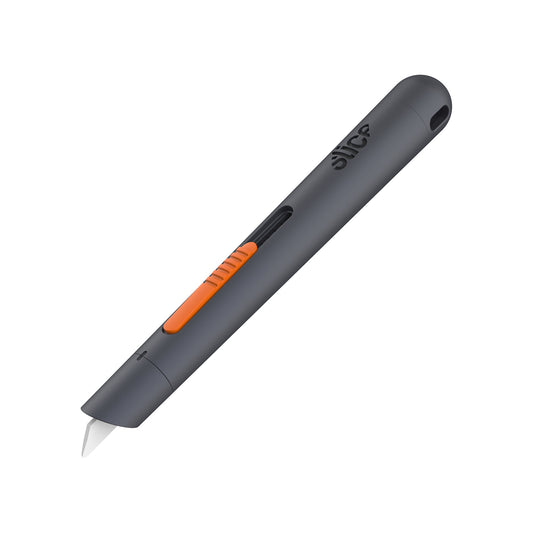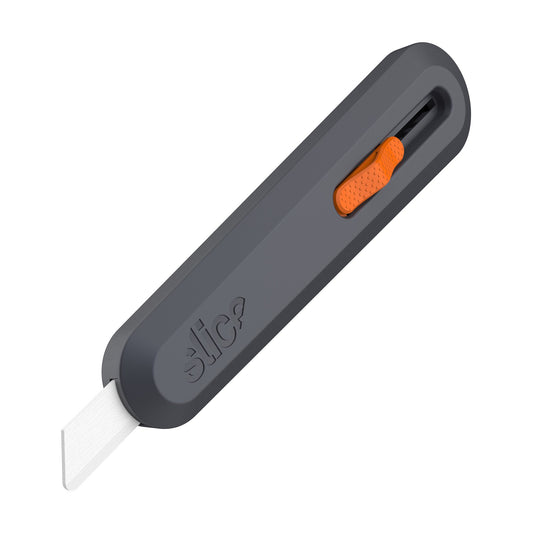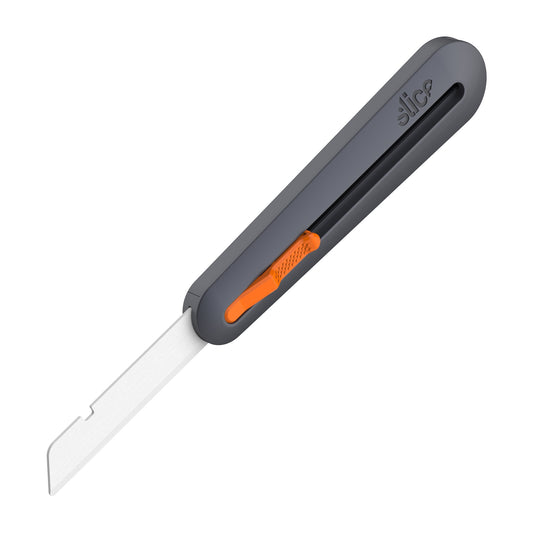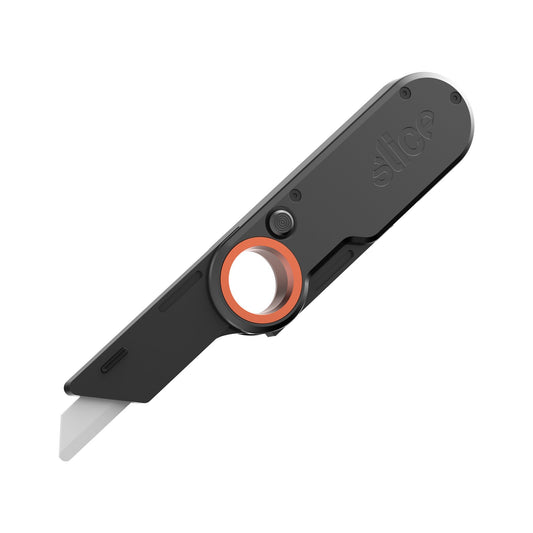Electrician’s Knife: An Eye on Safety
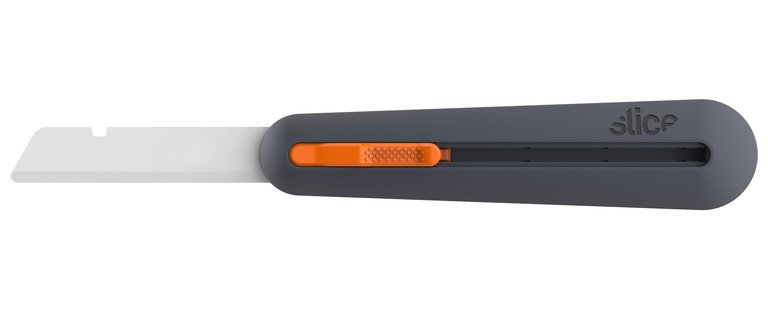
You will find an electrician’s knife in every electrician’s tool belt. Unfortunately, most knives pose puncture and laceration hazards to their users. Slice® makes the only knives with safer blades—they’re finger-friendly®.
There are several models of safer Slice cutting tools that work for electricians.
This video shows how the Slice Manual Utility Knife readily cuts through wire insulation without damaging the wires inside. Notice that the electrician who is demonstrating likes the Slice tool “because it doesn’t cut me”:
There is no single knife model used by electricians. They use the knife that best fits their needs, which may change from job to job. So when choosing the best electrician’s knife, it will largely depend on personal preference and the demands of the task at hand.
Whatever model you pick, though, the priority should be finding the safest cutting tool possible.
Hand dexterity is integral to an electrician’s work. Any cuts or punctures to the hand or forearm can temporarily sideline an electrician or cause permanent injuries. Avoiding such injuries requires knowing how to use an electrician’s knife safely. And if you start with a safer knife, whether it be an electrician’s pocket knife or utility knife, you greatly reduce the possibility of getting cut.
What Is an Electrician’s Knife Used For?
Let’s briefly look at the cutting needs of an electrician. Knife uses will vary, but one task that every electrician will have to perform is cutting wire insulation, as demonstrated in the video above.
Because the surface you’re cutting is small and moves easily—wires are meant to bend, after all—the chances of blade slippage are high. This is an instance of when dexterity and tool safety are particularly important.
Electricians also use cutting tools in a variety of other circumstances, like getting through packaging and cutting rubbery electrician’s tape. For this reason, electricians require a good all-around knife, just so long as it also performs well as a wire skinning knife.
Slice Cutting Tools for Electricians
In addition to the Manual Utility Knife, Slice general-use tools that work well for electricians include the Folding Utility Knife, Manual Industrial Knife, and Manual Pen Cutter.
The folding knife is a fixed-blade tool: open it to expose the blade, and close it for safe blade storage within the base of the handle. A finger-ring at the pivot point makes for easy storage and a convenient place to grab when retrieving the knife from a tool belt.
For deep cuts, look to one of our industrial knives. These tools handle like the Manual Utility Knife. Both tools provide several cutting depths to choose from. The Industrial Knife, however, exposes the blade up to a depth of 76 millimeters, while the maximum depth on the utility knife is 22 millimeters.
The versatile Pen Cutter is slightly smaller than the utility and industrial knives, and has a maximum cutting depth of 11 millimeters. It fits easily in a shirt or pants pocket.
Tight Spots and Copper Wire
The 10568 Scalpel is excellent for tight or awkward spots. This tools works with several types of Slice safety blades, including the straight-edge pointed-tip blade, the corner-stripping blade, and the 10537 pointed-tip seam ripper blade.

Slice makes ceramic safety scissors, which are another great addition to any electrician’s tool belt. The 10544 Small Scissors are great for smaller hands, while the finger holes of the 10545 Large Scissors fit any adult, especially those with larger hands, and they provide leverage so you can generate a good amount of force easily. Slice Pointed-Tip Scissors are great for everyday cutting and for when you need to puncture your material to initiate the cut.
All Slice scissors can cut a variety of materials, including copper wire, as this video shows:
Proper Ergonomics
Ergonomics refers to design that makes work environments or tools as efficient and comfortable as possible for the user. For tools, it addresses the questions: Can you use a natural movement to get the job done? Does the tool fit naturally in your hand? Is the handle properly weighted and balanced? Is the cutter easy to hold, operate, and grip?
These are all important questions to ask when choosing a safer electrician’s knife because good ergonomics reduce hand and arm fatigue. Fatigue is a primary cause of injuries.
Good ergonomic design also reduces the chances of creating repetitive stress injuries, another common workplace safety issue.
All Slice cutting products are ergonomically designed.

Safe Blades
Most blades are initially dangerously sharp; this holds true for metal blades and other ceramic blades. In fact, most other ceramic blades are sharper than metal blades.
At Slice, we’ve created an effective blade that is safe to the touch. This is thanks to our patent-pending finger-friendly blade manufacturing process.
To people used to dangerously sharp metal blades, a Slice blade feels a bit dull out of the box. But the only reason metal blades are so sharp to begin with is that they dull very quickly. Slice blades start at a safe sharpness and stay there for a very long time. Tests show that Slice blades last up to 11 times longer than their metal counterparts. If you are using the rounded-tip blades, you also don’t need a sharps box for blade disposal.
Non-Sparking, Non-Conductive, Non-Magnetic Tools
Electricians are exposed to electrical currents and other potential hazards. For added safety, many electricians look for knives that are non-sparking, non-conductive, and non-magnetic. All Slice blades feature these properties.
Additionally, Slice’s finger-friendly safety blades have these benefits:
- Never rust
- Oil and lubricant free
- Non-reactive: impervious to acids and salt
Many metal non-sparking knives don’t last long. Their composition—usually a copper, bronze, or brass alloy—is soft, so they dull quickly. As noted, Slice blades last much longer than steel, the most common blade material. And steel is stronger than brass, bronze, and copper, so Slice blades will last even longer when compared to these materials.
Go Safe or Go Home
Safety is an important aspect of an electrician’s day-to-day work. In fact, it can be the difference between getting to continue the job or not. With a safer electrician’s knife, you can help extend your injury-free days and your career.
Further Reading:
-
Manual Pen Cutter
Regular price $16.49 USDRegular priceUnit price per -
Manual Utility Knife
Regular price $29.49 USDRegular priceUnit price per -
Manual Industrial Knife
Regular price $31.99 USDRegular priceUnit price per -
Folding Utility Knife
Regular price $50.99 USDRegular priceUnit price per

